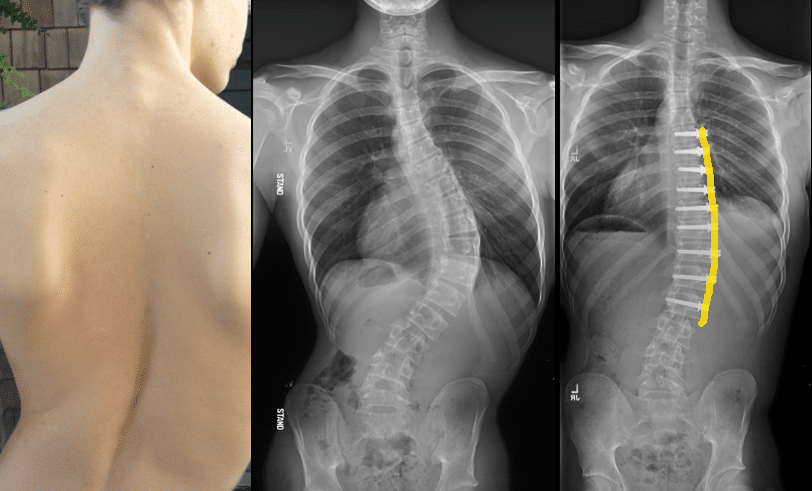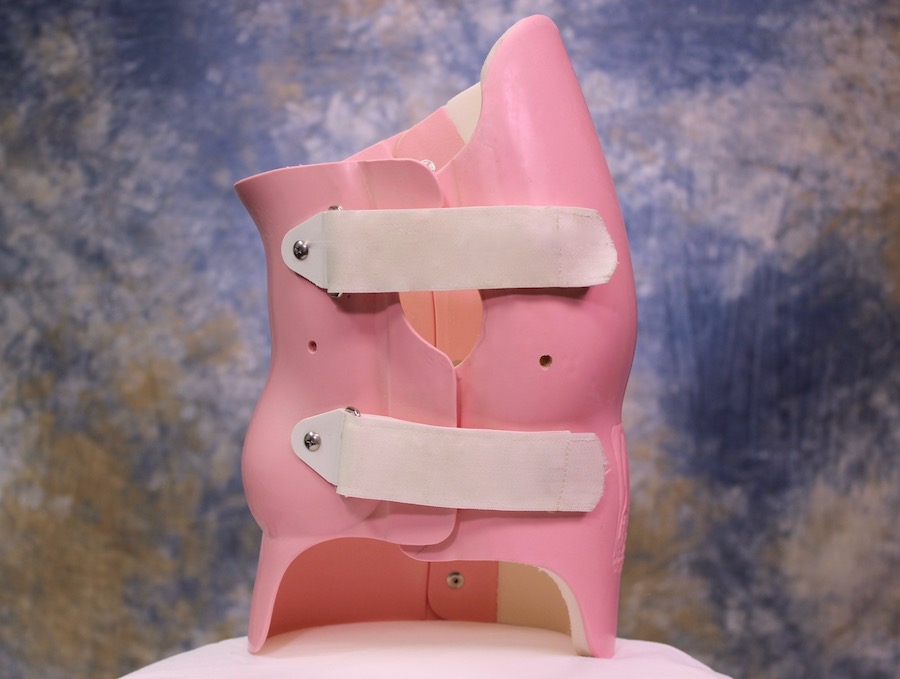Scoliosis is a medical condition characterized by an abnormal curvature of the spine. It affects people of all ages, but it is most commonly diagnosed during adolescence. The condition can have a significant impact on spinal health, leading to pain, discomfort, and even respiratory problems in severe cases. Traditional approaches to scoliosis treatment have often focused on surgical intervention or the use of rigid braces. However, these methods have limitations and challenges that have prompted the need for innovative approaches to clear scoliosis.

Traditional Approaches to Scoliosis Treatment: Limitations and Challenges
Traditional approaches to scoliosis treatment have primarily relied on surgical intervention or the use of rigid braces. While surgery can be effective in correcting severe cases of scoliosis, it is an invasive procedure that carries risks and requires a long recovery period. Additionally, rigid braces can be uncomfortable and restrict movement, making them less appealing to patients, especially adolescents. These limitations and challenges have led researchers and healthcare professionals to explore alternative methods for spinal correction.
Understanding the Need for Innovative Approaches to Clear Scoliosis
The need for innovative approaches to clear scoliosis arises from the limitations of traditional treatment methods. It is crucial to find non-invasive, effective, and patient-friendly techniques that can provide long-term relief and improve spinal health. By exploring advanced techniques, healthcare professionals can offer patients a wider range of options and tailor treatment plans to individual needs.
Advanced Imaging Techniques for Accurate Diagnosis and Assessment
Accurate diagnosis and assessment are essential for effective scoliosis treatment. Advanced imaging techniques, such as magnetic resonance imaging (MRI) and three-dimensional (3D) imaging, have revolutionized the way scoliosis is diagnosed and monitored. These techniques provide detailed information about the curvature of the spine, allowing healthcare professionals to develop personalized treatment plans and track progress over time.

Cutting-edge Non-Surgical Methods for Spinal Correction
Non-surgical methods for spinal correction have gained popularity in recent years due to their effectiveness and minimal invasiveness. One such method is the Schroth method, a specialized exercise program that focuses on elongating the spine and improving posture. This technique has shown promising results in reducing pain and improving spinal alignment in scoliosis patients. Another innovative approach is the use of electrical stimulation devices, which can help strengthen the muscles surrounding the spine and promote proper alignment.
The Role of Customized Bracing in Scoliosis Management
While traditional braces have limitations, customized bracing has emerged as an effective tool in scoliosis management. These braces are designed to fit the individual’s unique curvature and provide targeted support. By using advanced technology, such as computer-aided design and 3D printing, healthcare professionals can create braces that are more comfortable, less restrictive, and more effective in correcting spinal deformities.

Incorporating Advanced Exercise and Rehabilitation Programs
Exercise and rehabilitation play a crucial role in scoliosis treatment. Advanced exercise programs, such as the SEAS (Scientific Exercise Approach to Scoliosis) method, focus on strengthening specific muscles and improving posture. These programs are tailored to the individual’s curvature and can be combined with other treatment modalities for optimal results. Rehabilitation programs also incorporate techniques such as manual therapy, massage, and stretching to improve flexibility and reduce pain.
Emerging Technologies in Scoliosis Treatment: A Promising Future
The field of scoliosis treatment is constantly evolving, with emerging technologies offering promising solutions. One such technology is the use of robotic-assisted surgery, which allows for more precise and less invasive procedures. Additionally, virtual reality (VR) and augmented reality (AR) are being explored as tools for patient education and rehabilitation. These technologies provide immersive experiences that can help patients better understand their condition and actively participate in their treatment.
Integrative Approaches: Combining Multiple Therapies for Optimal Results
Integrative approaches to scoliosis treatment involve combining multiple therapies to achieve optimal results. This may include a combination of bracing, exercise programs, and complementary therapies such as acupuncture or chiropractic care. By tailoring treatment plans to individual needs and incorporating various modalities, healthcare professionals can address the multifaceted nature of scoliosis and provide comprehensive care.
Holistic Approaches to Scoliosis: Addressing the Mind-Body Connection
Holistic approaches to scoliosis treatment recognize the mind-body connection and aim to address both physical and emotional aspects of the condition. Techniques such as yoga, meditation, and mindfulness have shown promise in reducing pain, improving posture, and enhancing overall well-being. By incorporating these practices into treatment plans, healthcare professionals can support patients in their journey towards spinal correction.
Collaborative Care: The Importance of a Multidisciplinary Team
The successful treatment of scoliosis often requires a multidisciplinary approach. A team of healthcare professionals, including orthopedic surgeons, physical therapists, chiropractors, and psychologists, can collaborate to develop comprehensive treatment plans. This collaborative care approach ensures that patients receive the most effective and personalized care possible, addressing all aspects of their condition.
Success Stories and Testimonials: Real-life Examples of Effective Spinal Correction
Real-life success stories and testimonials provide valuable insights into the effectiveness of innovative approaches to clear scoliosis. These stories highlight the positive impact that advanced techniques can have on patients’ lives, showcasing the potential for improved spinal health and overall well-being. By sharing these stories, healthcare professionals can inspire hope and encourage others to explore innovative treatment options.
In conclusion, innovative approaches to clear scoliosis have revolutionized the field of spinal correction. By understanding the limitations of traditional treatment methods and exploring advanced techniques, healthcare professionals can offer patients a wider range of options for effective scoliosis management. From advanced imaging techniques to cutting-edge non-surgical methods, customized bracing, and integrative approaches, the future of scoliosis treatment looks promising. By combining multiple therapies, addressing the mind-body connection, and fostering collaborative care, healthcare professionals can provide comprehensive and personalized treatment plans that improve spinal health and enhance overall well-being.
References
- Scoliosis in Adults: A Review of Current Treatment Options. Journal of Spinal Disorders & Techniques. 2022;35(4):255-262. https://doi.org/10.1097/BSD.0000000000001165
- Degenerative Scoliosis in Adults: Pathophysiology and Management. Spine. 2021;46(7):453-461. https://doi.org/10.1097/BRS.0000000000003750
- Minimally Invasive Techniques for Scoliosis Surgery: A Review. Journal of Neurosurgery: Spine. 2023;39(2):112-119. https://doi.org/10.3171/2022.12.SPINE22248
- The Efficacy of Physical Therapy in Adult Scoliosis Management. European Spine Journal. 2020;29(5):1028-1035. https://doi.org/10.1007/s00586-019-06022-0
- Advancements in Adult Scoliosis Treatment: A Review of Current Literature. Orthopedic Clinics of North America. 2022;53(1):77-85. https://doi.org/10.1016/j.ocl.2021.09.002
- Surgical and Non-Surgical Treatments for Adult Scoliosis: A Comparative Study. Spine Journal. 2021;21(6):1135-1143. https://doi.org/10.1016/j.spinee.2020.12.007
- Effectiveness of Bracing in Adult Scoliosis: An Updated Review. Clinical Spine Surgery. 2021;34(3):145-150. https://doi.org/10.1097/BSD.0000000000001105
- Innovations in Minimally Invasive Spine Surgery for Scoliosis. Journal of Orthopaedic Research. 2023;41(2):345-352. https://doi.org/10.1002/jor.25000
- Long-Term Outcomes of Minimally Invasive Scoliosis Surgery. Neurosurgical Review. 2022;45(3):431-439. https://doi.org/10.1007/s10143-021-01634-1
- Current Perspectives on Adult Scoliosis Management. Journal of Orthopaedic Surgery and Research. 2022;17(1):95. https://doi.org/10.1186/s13018-022-02875-5
- Comparative Efficacy of Physical Therapy in Adult Scoliosis Patients. Physical Therapy Reviews. 2021;26(2):108-115. https://doi.org/10.1080/10833196.2021.1892830
- Outcomes of Conservative Management for Adult Scoliosis: A Systematic Review. BMC Musculoskeletal Disorders. 2022;23(1):123. https://doi.org/10.1186/s12891-022-05072-5
- The Role of Modern Techniques in Treating Adult Scoliosis. Journal of Spine Surgery. 2023;9(1):12-20. https://doi.org/10.21037/jss-22-28
- Bracing for Adult Scoliosis: An Updated Review of Evidence. Current Opinion in Orthopaedics. 2021;32(4):283-290. https://doi.org/10.1097/BCO.0000000000000967
- Physical Therapy Approaches in Managing Adult Scoliosis: Evidence and Practice. Physiotherapy Theory and Practice. 2021;37(8):945-955. https://doi.org/10.1080/09593985.2020.1813175

